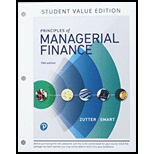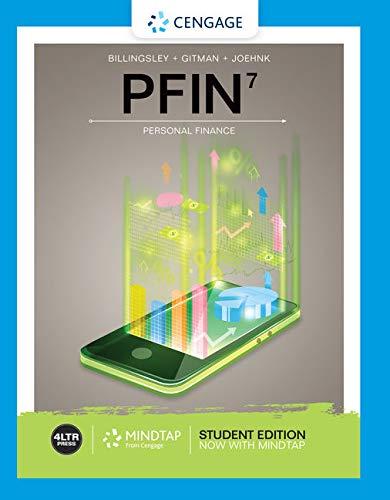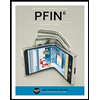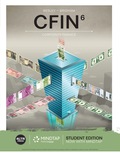
Principles of Managerial Finance, Student Value Edition (15th Edition) (The Pearson Series in Finance)
15th Edition
ISBN: 9780134478166
Author: Chad J. Zutter, Scott B. Smart
Publisher: PEARSON
expand_more
expand_more
format_list_bulleted
Question
Chapter 5, Problem 5.12P
Subpart (a)
Summary Introduction
To calculate:
Introduction:
Present value (PV): The present value refers to the today’s value of a future amount.
Subpart (b)
Summary Introduction
To calculate: Present value.
Introduction:
Present value (PV): The present value refers to the today’s value of a future amount.
Subpart (c)
Summary Introduction
To calculate: Present value.
Introduction:
Present value (PV): The present value refers to the today’s value of a future amount.
Subpart (d)
Summary Introduction
To discuss: Comparison of part “a”, “b” and “c”.
Expert Solution & Answer
Want to see the full answer?
Check out a sample textbook solution
Students have asked these similar questions
Don't use ai.
If you deposit $1,000 in a bank account earning 5% annual interest, how much will you have after 1 year?
A) $1,005B) $1,050C) $1,500D) $1,100
If you deposit $1,000 in a bank account earning 5% annual interest, how much will you have after 1 year?
A) $1,005B) $1,050C) $1,500D) $1,100
No AI
You take a loan of $10,000 at 8% annual interest to be repaid in 4 equal annual installments. What is the annual payment?
Chapter 5 Solutions
Principles of Managerial Finance, Student Value Edition (15th Edition) (The Pearson Series in Finance)
Ch. 5.1 - What is the difference between future value and...Ch. 5.1 - Define and differentiate among the three basic...Ch. 5.2 - Prob. 5.3RQCh. 5.2 - Prob. 5.4RQCh. 5.2 - Prob. 5.5RQCh. 5.2 - Prob. 5.6RQCh. 5.2 - Prob. 5.7RQCh. 5.3 - What is the difference between an ordinary annuity...Ch. 5.3 - What are the most efficient ways to calculate the...Ch. 5.3 - How can the formula for the future value of an...
Ch. 5.3 - Prob. 5.13RQCh. 5.3 - What is a perpetuity? Why is the present value of...Ch. 5.4 - How do you calculate the future value of a mixed...Ch. 5.5 - What effect does compounding interest more...Ch. 5.5 - Prob. 5.21RQCh. 5.5 - Differentiate between a nominal annual rate and an...Ch. 5.6 - How can you determine the size of the equal,...Ch. 5.6 - Prob. 5.27RQCh. 5.6 - How can you determine the unknown number of...Ch. 5 - Learning Goals 2, 5 ST5-1 Future values for...Ch. 5 - Learning Goal 3 ST5-2 Future values of annuities...Ch. 5 - Prob. 5.3STPCh. 5 - Learning Goal 6 ST5-4 Deposits needed to...Ch. 5 - Assume that a firm makes a 2,500 deposit into a...Ch. 5 - Prob. 5.2WUECh. 5 - Prob. 5.3WUECh. 5 - Your firm has the option of making an investment...Ch. 5 - Joseph is a friend of yours. He has plenty of...Ch. 5 - Jack and Jill have just had their first child. If...Ch. 5 - Prob. 5.1PCh. 5 - Learning Goal 2 P5-2 Future value calculation...Ch. 5 - Prob. 5.4PCh. 5 - Prob. 5.5PCh. 5 - Learning Goal 2 P5- 6 Time value As part of your...Ch. 5 - Learning Goal 2 P5-7 Time value you can deposit...Ch. 5 - Learning Goal 2 P5-8 Time value Misty needs to...Ch. 5 - Learning Goal 2 P5- 9 Single-payment loan...Ch. 5 - Prob. 5.10PCh. 5 - Prob. 5.11PCh. 5 - Prob. 5.12PCh. 5 - Prob. 5.13PCh. 5 - Time value An Iowa state savings bond can be...Ch. 5 - Time value and discount rates You just won a...Ch. 5 - Prob. 5.16PCh. 5 - Cash flow investment decision Tom Alexander has an...Ch. 5 - Learning Goal 2 P5-18 Calculating deposit needed...Ch. 5 - Future value of an annuity for each case in the...Ch. 5 - Present value of an annuity Consider the following...Ch. 5 - Learning Goal 3 P5-21 Time value: Annuities Marian...Ch. 5 - Learning Goal 3 P5-22 Retirement planning Hal...Ch. 5 - Learning Goal 3 P5-23 Value of a retirement...Ch. 5 - Learning Goal 2, 3 P5-25 Value of an annuity...Ch. 5 - Prob. 5.26PCh. 5 - Prob. 5.30PCh. 5 - Learning Goal 4 P5-31 Value of a single amount...Ch. 5 - Value of mixed streams Find the present value of...Ch. 5 - Prob. 5.33PCh. 5 - Prob. 5.34PCh. 5 - Prob. 5.36PCh. 5 - Prob. 5.37PCh. 5 - Changing compounding frequency Using annual,...Ch. 5 - Prob. 5.39PCh. 5 - Prob. 5.40PCh. 5 - Compounding frequency and time value You plan to...Ch. 5 - Learning Goals 3, 5 P5-42 Annuities and...Ch. 5 - Prob. 5.43PCh. 5 - Prob. 5.44PCh. 5 - Prob. 5.45PCh. 5 - Prob. 5.46PCh. 5 - Prob. 5.47PCh. 5 - Loan amortization schedule Joan Messineo borrowed...Ch. 5 - Prob. 5.49PCh. 5 - Prob. 5.50PCh. 5 - Prob. 5.52PCh. 5 - Prob. 5.53PCh. 5 - Prob. 5.54PCh. 5 - Prob. 5.55PCh. 5 - Prob. 5.56PCh. 5 - Prob. 5.57PCh. 5 - Number of years needed to acccumulate a future...Ch. 5 - Prob. 5.59PCh. 5 - Prob. 5.60PCh. 5 - Time to repay Installment loan Mia Saito wishes to...
Knowledge Booster
Similar questions
- You take a loan of $10,000 at 8% annual interest to be repaid in 4 equal annual installments. What is the annual payment?arrow_forwardNeed help!! A stock pays a constant dividend of $2.50 per year. If the required rate of return is 10%, what is the value of the stock? A) $20.00B) $22.50C) $25.00D) $27.50arrow_forwardA stock pays a constant dividend of $2.50 per year. If the required rate of return is 10%, what is the value of the stock? A) $20.00B) $22.50C) $25.00D) $27.50arrow_forward
- Don't use chatgpt i will give unhelpful! The beta of a stock is 1.2, the risk-free rate is 3%, and the expected market return is 9%. What is the expected return of the stock using the CAPM?arrow_forwardNo ai A project requires an initial investment of $5,000 and returns $2,000 per year for 3 years. What is the Net Present Value (NPV) at a discount rate of 10%? A) $375.66B) $420.50C) $487.23D) $512.67arrow_forwardWhat is the effective annual rate (EAR) for a nominal interest rate of 12% compounded monthly? A) 12.00%B) 12.36%C) 12.68%D) 13.00%arrow_forward
- Don't use chatgpt. The beta of a stock is 1.2, the risk-free rate is 3%, and the expected market return is 9%. What is the expected return of the stock using the CAPM?arrow_forwardA company's stock is expected to grow at 5% annually. The next dividend is $3, and the required rate of return is 10%. What is the stock’s value using the Gordon Growth Model?arrow_forwardDon't use ai . The beta of a stock is 1.2, the risk-free rate is 3%, and the expected market return is 9%. What is the expected return of the stock using the CAPM?arrow_forward
- The beta of a stock is 1.2, the risk-free rate is 3%, and the expected market return is 9%. What is the expected return of the stock using the CAPM?arrow_forwardIf you invest $1,000 at an annual interest rate of 5% compounded annually, how much will you have after 3 years?need help!!arrow_forwarddon't use chatgpt. If you invest $1,000 at an annual interest rate of 5% compounded annually, how much will you have after 3 years?arrow_forward
arrow_back_ios
SEE MORE QUESTIONS
arrow_forward_ios
Recommended textbooks for you
 Pfin (with Mindtap, 1 Term Printed Access Card) (...FinanceISBN:9780357033609Author:Randall Billingsley, Lawrence J. Gitman, Michael D. JoehnkPublisher:Cengage Learning
Pfin (with Mindtap, 1 Term Printed Access Card) (...FinanceISBN:9780357033609Author:Randall Billingsley, Lawrence J. Gitman, Michael D. JoehnkPublisher:Cengage Learning PFIN (with PFIN Online, 1 term (6 months) Printed...FinanceISBN:9781337117005Author:Randall Billingsley, Lawrence J. Gitman, Michael D. JoehnkPublisher:Cengage Learning
PFIN (with PFIN Online, 1 term (6 months) Printed...FinanceISBN:9781337117005Author:Randall Billingsley, Lawrence J. Gitman, Michael D. JoehnkPublisher:Cengage Learning EBK CONTEMPORARY FINANCIAL MANAGEMENTFinanceISBN:9781337514835Author:MOYERPublisher:CENGAGE LEARNING - CONSIGNMENT
EBK CONTEMPORARY FINANCIAL MANAGEMENTFinanceISBN:9781337514835Author:MOYERPublisher:CENGAGE LEARNING - CONSIGNMENT Principles of Accounting Volume 2AccountingISBN:9781947172609Author:OpenStaxPublisher:OpenStax College
Principles of Accounting Volume 2AccountingISBN:9781947172609Author:OpenStaxPublisher:OpenStax College

Pfin (with Mindtap, 1 Term Printed Access Card) (...
Finance
ISBN:9780357033609
Author:Randall Billingsley, Lawrence J. Gitman, Michael D. Joehnk
Publisher:Cengage Learning

PFIN (with PFIN Online, 1 term (6 months) Printed...
Finance
ISBN:9781337117005
Author:Randall Billingsley, Lawrence J. Gitman, Michael D. Joehnk
Publisher:Cengage Learning

EBK CONTEMPORARY FINANCIAL MANAGEMENT
Finance
ISBN:9781337514835
Author:MOYER
Publisher:CENGAGE LEARNING - CONSIGNMENT


Principles of Accounting Volume 2
Accounting
ISBN:9781947172609
Author:OpenStax
Publisher:OpenStax College